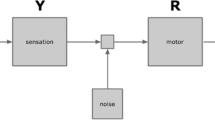Abstract
Neural systems process information. This platitude contains an interesting ambiguity between multiple senses of the term “information.” According to a popular thought, the ambiguity is best resolved by reserving semantic concepts of information for the explication of neural activity at a high level of organization, and quantitative concepts of information for the explication of neural activity at a low level of organization. This article articulates the justification behind this view, and concludes that it is an oversimplification. An analysis of the meaning of claims about Shannon information rates in the spiking activity of neurons is then developed. On the basis of that analysis, it is shown that quantitative conceptions of information are more intertwined with semantic concepts than they seem to be, and, partially for that reason, are also more philosophically interesting.
Similar content being viewed by others
Notes
For a discussion of this issue, see Chapter 8 of Dennett (2017).
Notice that this strategy entails, but is not entailed by, the necessary condition for the attribution of semantic properties mentioned above. This places Dennett’s approach to semantic information within the naturalistic tradition.
But see Rathkopf (2017) for a recent exception.
References
Bennett MR, Hacker PMS (2003) Philosophical foundations of neuroscience, 1st edn. Wiley, Malden
Borst A, Theunissen FE (1999) Information theory and neural coding. Nat Neurosci 2(11):947–957
Calcott B, Griffiths PE, Pocheville A (2017) Signals that make a difference. Br J Philos Sci
Cao R (2012) A teleosemantic approach to information in the brain. Biol Philos 27(1):49–71
Dayan P, Abbott LF (2001) Theoretical neuroscience, vol 10. MIT Press, Cambridge, MA
Dennett DC (1989) The intentional stance. MIT press, Cambridge
Dennett DC (1996) Darwin’s dangerous idea: evolution and the meanings of life. Simon & Schuster, New York
Dennett DC (2017) From bacteria to bach and back: the evolution of minds. Penguin, London
Godfrey-Smith P (2011) Signals: evolution, learning, and information, by Brian Skyrms. Mind 120(480):1288–1297
Godfrey-Smith P, Martínez M (2013) Communication and common interest. PLoS Comput Biol 9(11):e1003282
Godfrey-Smith P, Sterelny K (2008) Biological information. In: Zalta EN (ed) The Stanford Encyclopedia of Philosophy. Metaphysics Research Lab, Stanford University, Stanford fall 2008 edition.
Harms WF (2006) What is information? three concepts. Biol Theory 1(3):230–242
Koch K, McLean J, Berry M, Sterling P, Balasubramanian V, Freed MA (2004) Efficiency of information transmission by retinal ganglion cells. Curr Biol 14(17):1523–1530
Levy W, Baxter RA (2002) Energy-efficient neuronal computation via quantal synaptic failures. J Neurosci 22(11):4746–4755
McCulloch WS, Pitts W (1943) A logical calculus of the ideas immanent in nervous activity. Bull Math Biophys 5(4):115–133
Meister M, Berry MJ (1999) The neural code of the retina. Neuron 22(3):435–450
Ovsepian SV, Dolly JO (2011) Dendritic snares add a new twist to the old neuron theory. Proc Natl Acad Sci 108(48):19113–19120
Piccinini G, Scarantino A (2011) Information processing, computation, and cognition. J Biol Phys 37(1):1–38
Rathkopf C (2017) Neural information and the problem of objectivity. Biol Philos 32(3):321–336
Rieke F, Warland D, Bialek W (1993) Coding efficiency and information rates in sensory neurons. EPL (Europhys Lett) 22(2):151
Rutherford ST, Bassler BL (2012) Bacterial quorum sensing: its role in virulence and possibilities for its control. Cold Spring Harbor Perspect Med 2(11):a012427
Shannon CE, Weaver W (1949) The mathematical theory of information. University of Illinois Press, Champaign
Sharpee T, Rust NC, Bialek W (2004) Analyzing neural responses to natural signals: maximally informative dimensions. Neural Comput 16(2):223–250
Skyrms B (2010) Signals: evolution, learning, and information. Oxford University Press, New York
Vinga S (2013) Information theory applications for biological sequence analysis. Brief Bioinform 15(3):376–389
Author information
Authors and Affiliations
Corresponding author
Ethics declarations
Conflict of interest
The authors declare that they have no conflict of interest.
Rights and permissions
About this article
Cite this article
Rathkopf, C. What Kind of Information is Brain Information?. Topoi 39, 95–102 (2020). https://doi.org/10.1007/s11245-017-9512-6
Published:
Issue Date:
DOI: https://doi.org/10.1007/s11245-017-9512-6




